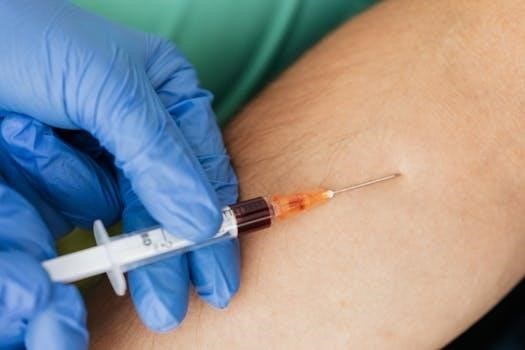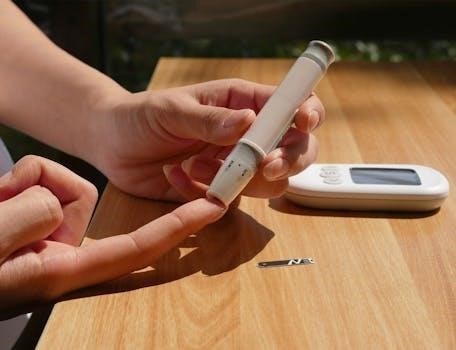Fitzpatrick Skin Type Test⁚ An Overview
The Fitzpatrick Skin Type Test, often found in PDF format, assesses how skin reacts to sun exposure. It categorizes skin into six types based on factors like hair and eye color, and tanning ability. This aids in understanding individual sun sensitivity and risk.
The Fitzpatrick scale, a cornerstone in dermatology, is a classification system developed to categorize human skin types based on their response to ultraviolet (UV) radiation. Initially created by Dr. Thomas B. Fitzpatrick in 1975, it provides a framework to understand how different individuals react to sun exposure, primarily focusing on the tendency to burn or tan. This scale, often accessed via PDF documents, is crucial for assessing sun sensitivity and informing decisions about sun protection and cosmetic procedures. The Fitzpatrick scale examines various factors, including skin color, hair color, and eye color, along with the individual’s history of tanning and burning. It is a valuable tool for healthcare professionals, beauty therapists, and individuals seeking personalized skincare advice. The scale’s widespread use underscores its importance in understanding the diverse ways in which people’s skin interacts with sunlight.
Purpose of the Fitzpatrick Skin Type Test
The primary purpose of the Fitzpatrick Skin Type Test, frequently encountered in PDF formats, is to determine an individual’s skin’s sensitivity to ultraviolet (UV) radiation. This assessment helps in predicting how a person’s skin will react to sun exposure, specifically their tendency to burn or tan. By categorizing individuals into one of six skin types, the test provides a basis for personalized sun protection strategies. This is particularly valuable in preventing sun damage, including sunburns, premature aging, and skin cancer. The test also aids dermatologists and skincare professionals in tailoring treatments and procedures to each patient’s specific needs. It guides in selecting appropriate cosmetic products and treatment modalities, ensuring efficacy and minimizing the risk of adverse reactions. Furthermore, the test helps individuals better understand their skin and make informed choices about sun protection, ultimately promoting skin health and safety. The Fitzpatrick test is an essential tool in both medical and cosmetic dermatology.

Understanding Skin Types I-VI
The Fitzpatrick scale classifies skin into six types, from Type I, which always burns and never tans, to Type VI, which rarely burns. Each type has distinct characteristics and sun sensitivity, guiding sun protection.
Skin Type I⁚ Characteristics and Sun Sensitivity
Individuals with Fitzpatrick Skin Type I exhibit very pale or white skin. This skin type is highly sensitive to ultraviolet radiation (UVR) and is characterized by a tendency to always burn when exposed to the sun. They rarely, if ever, tan. People with this skin type often have red or blonde hair and light-colored eyes, such as blue or green. The presence of freckles is also common, even in unexposed areas. Due to the low melanin content, this skin type is at the highest risk of sun damage. Therefore, they need to take extra precautions to protect their skin from the harmful effects of the sun. They should consistently use high-SPF sunscreens, wear protective clothing, and seek shade during peak sun hours. The skin of those with this type doesn’t turn brown even after hours of exposure, and the face reacts very poorly to the sun, quickly showing redness and burning. They have minimal protection against the sun’s harmful rays.
Skin Type II⁚ Characteristics and Sun Sensitivity
Fitzpatrick Skin Type II is characterized by pale skin that is still quite sensitive to sun exposure. Individuals with this skin type tend to burn easily when exposed to the sun, although they may develop some tan with repeated exposure. They often have light hair, such as blonde or light brown, and light-colored eyes, like blue, green, or hazel. Freckles are commonly present, particularly on areas exposed to the sun. While not as prone to burning as Type I, they still require careful sun protection. This includes the regular use of sunscreen with a high SPF, protective clothing, and seeking shade during the sun’s peak hours. They are still at high risk of sun damage and should avoid prolonged sun exposure. Their skin will usually burn first before it develops a tan. They might achieve a tan, but it will not be a deep tan. Their facial skin is sensitive to the sun, showing redness and burning after excessive exposure. While slightly more resilient than Type I, those with Type II must still take considerable precautions.
Skin Type III⁚ Characteristics and Sun Sensitivity
Fitzpatrick Skin Type III represents an intermediate category with moderate sensitivity to the sun. Individuals with this skin type typically possess a complexion that ranges from fair to light olive. They may have dark blonde or light brown hair, and eye colors can be varied, including hazel, brown, and green. While they can develop a tan, they are still susceptible to sunburns, particularly with prolonged sun exposure. They typically turn brown after sun exposure, but not within the first few hours. Their skin will gradually tan, but will burn if exposed to excessive sunlight. Freckles may be present, though not as pronounced as in Types I and II. When in the sun, they should use sunscreen, seek shade, and wear protective clothing. They might experience some redness after being in the sun. However, the skin will tan with repeated exposure. They may also experience sun-related aging and are still at risk of skin cancer. Individuals of this type should always take the necessary precautions.

Skin Type IV⁚ Characteristics and Sun Sensitivity
Fitzpatrick Skin Type IV is characterized by a moderate to olive or light brown skin tone. People with this skin type often have dark hair and dark eyes, usually brown or black. They tan easily and rarely burn, which is a significant distinction from the earlier skin types. Their skin develops a tan quickly and deeply with sun exposure. Individuals with skin type IV can spend time in the sun with minimal risk of burning. Although they are less prone to sunburn than those with lighter skin, they are not immune to the harmful effects of UV radiation. Therefore, they still need to protect their skin, using appropriate sunscreen and other sun-protective measures. This skin type is more resistant to burning but still needs sun protection. They turn brown with sun exposure and can get some sun damage. They might experience some redness after sun exposure, but it quickly develops into a tan. It is important for them to use sun protection to prevent long-term sun damage, such as wrinkles and hyperpigmentation.
Skin Type V⁚ Characteristics and Sun Sensitivity
Fitzpatrick Skin Type V is characterized by brown or dark brown skin. Individuals with this skin type typically have dark hair and dark eyes, often black or very dark brown. They have a high degree of pigmentation and tan very easily, rarely experiencing sunburn. Their skin tans very quickly and intensely with sun exposure; People with type V skin have a lower risk of sunburn than those with lighter skin types due to higher melanin production. This inherent protection, however, does not mean they are immune to the harmful effects of UV radiation. The sun can still cause damage such as premature aging, wrinkles, and hyperpigmentation, even if burning is infrequent. Therefore, it’s important for individuals with type V skin to use sunscreen and other sun-protective measures. They are also prone to hyperpigmentation, which can be exacerbated by sun exposure. They may notice a change in skin tone after sun exposure as it becomes darker and more intensely pigmented. Despite their natural resistance to burning, sun protection is still vital for maintaining healthy skin.
Skin Type VI⁚ Characteristics and Sun Sensitivity
Fitzpatrick Skin Type VI represents the darkest end of the spectrum, characterized by deeply pigmented, dark brown to black skin. People with this skin type typically have black hair and dark brown or black eyes. They rarely, if ever, burn when exposed to the sun. Their skin tans very easily and deeply, and it is naturally very resistant to sunburn. Type VI individuals have the highest amount of melanin, which provides a significant natural protective barrier against ultraviolet radiation. While they are less prone to sunburn, they are not immune to the harmful effects of the sun. Prolonged sun exposure can still cause sun damage, including premature aging, wrinkles, and hyperpigmentation. The increased melanin production in skin type VI can also lead to hyperpigmentation issues, especially in areas exposed to the sun. Individuals with type VI skin should practice sun safety, wear sun protective clothing and use sunscreen. Although they may not experience burning, long-term sun exposure can still increase their risk for skin cancer.

Practical Application of the Test
The Fitzpatrick test, often accessed via PDF charts, is used for self-assessment to determine skin type. This helps guide decisions on sun protection, skincare product choices, and cosmetic procedures, based on individual sensitivity to sun exposure.

Self-Assessment Using the Fitzpatrick Chart
Self-assessment using a Fitzpatrick Skin Type Chart, often available as a PDF, involves a systematic approach to categorizing your skin’s reaction to sun exposure. The chart typically includes a questionnaire that considers factors like your natural hair and eye color, and your skin’s response to sunlight. You’ll likely be asked about your tendency to burn versus tan, the degree to which you tan, and whether you have freckles in areas not exposed to the sun.
By answering these questions and assigning a score based on the provided scales, you can determine your Fitzpatrick skin type, ranging from I to VI. Each type corresponds to a different level of melanin production and sun sensitivity. The PDF chart will guide you through the scoring process, providing a range of scores for each of the six skin types. This self-assessment process is a straightforward and useful way to understand your skin’s specific needs, allowing you to make more informed choices about sun protection and skincare. Remember, though, that this is a guide, not a substitute for professional advice.
Factors Influencing Skin Type Assessment
Several factors can influence the accuracy of a skin type assessment using the Fitzpatrick chart, often accessed via a PDF. While the chart primarily relies on genetic predisposition and sun reaction, other elements can introduce variability. For instance, your natural skin color in unexposed areas, hair color (both natural and before aging), and eye color provide initial clues. The presence of freckles on unexposed skin also plays a role, indicating a tendency towards sun sensitivity.
Furthermore, your personal history of sun exposure greatly impacts assessment. How your skin reacts to prolonged sun exposure, whether you burn easily or tan, and the speed and degree of tanning, are crucial. It’s vital to consider your typical reaction to the sun rather than a one-off experience. Moreover, certain medications or skin conditions might temporarily alter your skin’s reaction to sunlight, potentially influencing your Fitzpatrick skin type assessment. It’s essential to account for these factors to obtain an accurate understanding of your skin’s inherent sun sensitivity using the Fitzpatrick scale and associated PDF resources.
Limitations of the Traditional Fitzpatrick Scale
While the Fitzpatrick Scale, often consulted via a PDF document, is a widely used tool, it has limitations. One key issue is its origin based on a primarily Caucasian population. This makes it less accurate for individuals with mixed ethnicities or those from diverse backgrounds, as it may not fully capture the spectrum of skin responses to UV radiation. The scale’s simplicity, while convenient, can oversimplify the complex interplay of factors influencing skin pigmentation and sun sensitivity.
Furthermore, the scale relies on self-reported sun reactions, which can be subjective and inconsistent. Individuals may inaccurately recall past experiences, or they might not have had sufficient sun exposure to accurately gauge their skin’s response. Additionally, the traditional Fitzpatrick scale doesn’t fully account for variations within skin types. For example, individuals within the same type may exhibit different levels of melanin production and varying susceptibilities to sun damage. As a result, the Fitzpatrick scale, while a valuable starting point, shouldn’t be the sole determinant for assessing an individual’s sun sensitivity and risk, particularly when considering the diverse populations we see today and their reactions to sun exposure according to pdf documents on the topic.
